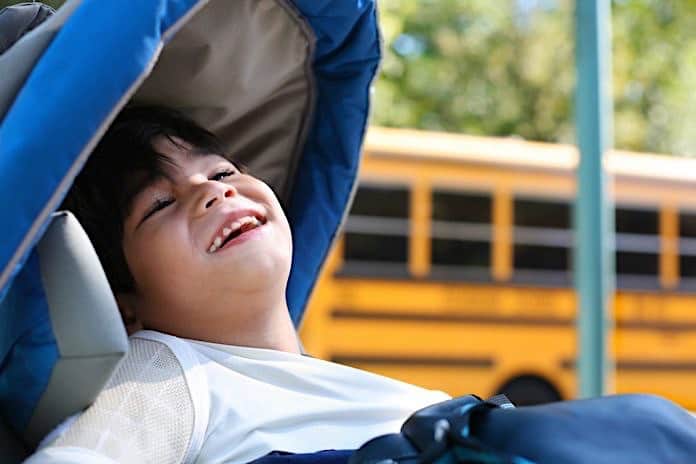Children with disabilities, like cerebral palsy, are more likely than other kids to be victims of bullying. The school bus is a place where these children are especially vulnerable. School transportation workers have an important role to play in keeping kids safe every day, and that extends to protecting the vulnerable from bullying. Along with teachers, administrators and parents, bus drivers can contribute to preventing harmful bullying.
Riding the Bus with a Disability
Children with cerebral palsy may have a range of disabilities that can be mild, moderate or severe. The condition is related to movement and often impacts the ability to walk and to control muscles, balance, posture and coordination. A child with cerebral palsy often looks different because of these physical symptoms and may have challenges getting on and off the bus.
For more severe disabilities a child may need to ride a specially-equipped bus, but many children with milder impairments ride with the other kids. Because they look and move differently and may be perceived as being less able to speak out or fight back, they are more likely than other kids to be targeted by a bully. The bus can be a particularly dangerous place for a bullying victim because there is nowhere to go to escape the harassment and because it is difficult for the bus driver to monitor everything that goes on behind them or to stop the bus to take action.
What Bus Drivers Can Do to Protect Vulnerable Children
Protecting disabled children from bullying is the responsibility of school staff as well as parents. When bullying takes place on the bus or on other school facilities, the adults in charge need to take actions that are both preventive and that stop bullying as it happens. Bus drivers should be included in any anti-bullying or bullying prevention training. In addition to being a part of any training or school-wide policies and procedures involving bullying, there are some other things bus drivers can do to protect their passengers:
- Stop safely to react to bullying. When there are signs that someone is being bullied the driver should stop the bus and take action that is assertive but calm. Of course, it is important to stop in a safe location.
- Approach a bully by name. The first action that will stop bullying in most cases is to calmly approach the perpetrator, use his or her name and give a verbal warning.
- Call the dispatch office. When a verbal warning is not enough to stop the bullying, a driver can call dispatch for assistance. Often, this second step will stop the bully.
- Report all incidences. Bus drivers should report these incidents through whatever procedure is outlined in the school’s policy. Having a record about what has happened can help if the problem persists.
- Get involved in IEPs. Drivers who have a disabled child on their route should be involved in IEP meetings. As a daily figure in the child’s life, the bus driver needs to know the scope of the special needs and the accommodations that should be provided. Being aware of a child’s needs can help prevent bullying and also help the driver contribute to solutions if the child is already the victim of a bully.
- Use a paraprofessional or camera system, if needed. When a bullying problem continues, more steps may be needed to keep a child safe. Having a paraprofessional ride with the child helps provide protection when the driver has to focus on the road. A camera can also help. These solutions cost money, of course, so school districts should examine their current efficiencies to determine where funding could come from, as well as consult with the school administration about how such additional provisions could reduce risk and liability. These could end up being much more expensive to the district in the long run.
- Have clear, simple rules with consequences. To prevent bullying, bus drivers need to have a few simple and clear rules for the bus that include no bullying. Enforcing these rules calmly and fairly with real consequences will help prevent negative behaviors.
- Reinforce positive behaviors. Bus drivers can also promote a positive environment by taking note of and recognizing good behaviors. Getting to know the students on the bus and taking the time to recognize each one fosters positive relationships and better behaviors.
Bullying on the bus is a real problem, and bus drivers should be a part of the solution. It is part of the job to protect children, not just with safe driving, but also by creating and maintaining a safe and positive environment. Any bus driver who does not feel adequately prepared to deal with bullying should talk to administrators about training or the implementation of anti-bullying policies.
Cerebral Palsy is a neurological disorder marking muscle coordination. In most cases, cerebral palsy is caused by brain damage that develops while the baby is still in utero or during or shortly after birth. Comprehensive information about cerebral palsy and most common types can be found at cerebralpalsyguidance.com


















